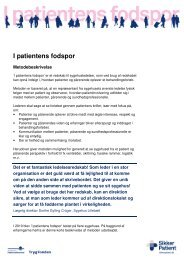How to Design Reliable Processes in Healthcare - Sikker Patient
How to Design Reliable Processes in Healthcare - Sikker Patient
How to Design Reliable Processes in Healthcare - Sikker Patient
You also want an ePaper? Increase the reach of your titles
YUMPU automatically turns print PDFs into web optimized ePapers that Google loves.
<strong>How</strong> <strong>to</strong> <strong>Design</strong> <strong>Reliable</strong><br />
<strong>Processes</strong> <strong>in</strong> <strong>Healthcare</strong><br />
Prepared and Presented<br />
Frank Federico, Roger Resar, and Karen Dodt<br />
Day 1<br />
17 August 2010<br />
1300-1400
©2010 Institute for <strong>Healthcare</strong> Improvement<br />
Observation: The reliability of<br />
apply<strong>in</strong>g known or required processes<br />
commonly is 80% or worse<br />
(When deal<strong>in</strong>g with non-catastrophic processes)<br />
Why should you care
©2010 Institute for <strong>Healthcare</strong> Improvement<br />
Example of 3 Step <strong>Design</strong> <strong>in</strong> Implement<strong>in</strong>g the<br />
Ventila<strong>to</strong>r Bundle<br />
Basel<strong>in</strong>e<br />
Education<br />
Feedback on<br />
compliance<br />
Integrate daily<br />
goals with MDR<br />
<strong>to</strong> identify<br />
defects as a<br />
RT built <strong>in</strong><strong>to</strong> 1<br />
hour scheduled<br />
vent checks as a)
©2010 Institute for <strong>Healthcare</strong> Improvement<br />
Framework for <strong>Reliable</strong> <strong>Design</strong><br />
• Process is the action po<strong>in</strong>t of all improvement<br />
methodologies<br />
• Reliability occurs by design not by accident<br />
• Segmentation allows the perfection of the design
©2010 Institute for <strong>Healthcare</strong> Improvement<br />
Start<strong>in</strong>g Labels of Reliability<br />
• Chaotic process: Failure <strong>in</strong> greater than 20% of<br />
opportunities<br />
• 80 or 90 % success. 1 or 2 failures out of 10 opportunities<br />
• 95% success: 5 failures or less out of 100 opportunities<br />
• Success <strong>in</strong> parts per one thousand: 5 failures or less out<br />
of 1000 opportunities
©2010 Institute for <strong>Healthcare</strong> Improvement<br />
Premises – IHI Innovation Team<br />
For healthcare processes where failure does not<br />
cause immediate catastrophic consequences:<br />
• 80% or less performance demonstrates that staff do not<br />
consistently and clearly understand the process (5 front l<strong>in</strong>e<br />
process users can not easily describe the process)<br />
• 95% or better: performance has some variation but 5 front<br />
l<strong>in</strong>e users can easily articulate the process.<br />
• Parts per thousand: performance <strong>in</strong>dicates a well designed<br />
system with low variation and cooperative relationships
©2010 Institute for <strong>Healthcare</strong> Improvement<br />
Non-Catastrophic <strong>Processes</strong><br />
• Def<strong>in</strong>ition: Failure of the process does not lead <strong>to</strong> death<br />
or severe <strong>in</strong>jury with<strong>in</strong> hours of the failure<br />
• 80% or less reliability is most commonly seen <strong>in</strong> these<br />
processes (hand-wash<strong>in</strong>g as an example)<br />
• Poor outcomes do not occur with each defect due <strong>to</strong><br />
either <strong>to</strong> biologic or system resilience.
©2010 Institute for <strong>Healthcare</strong> Improvement<br />
Reasons for the Reliability Gap In<br />
<strong>Healthcare</strong><br />
• Current Improvement methods <strong>in</strong> healthcare are highly<br />
dependent on vigilance and hard work<br />
• The focus on benchmarked outcomes tends <strong>to</strong><br />
exaggerate the reliability with<strong>in</strong> healthcare hence giv<strong>in</strong>g<br />
both cl<strong>in</strong>icians and leadership a false sense of security<br />
• Often excessive cl<strong>in</strong>ical au<strong>to</strong>nomy creates and allows<br />
wide performance marg<strong>in</strong>s<br />
• The use of deliberate designs <strong>to</strong> achieve reliability goals<br />
seldom occurs
©2010 Institute for <strong>Healthcare</strong> Improvement<br />
Improvement Concepts Associated with Performance<br />
Result<strong>in</strong>g <strong>in</strong> 80-90% Process Reliability<br />
(Primarily can be described as <strong>in</strong>tent, vigilance, and<br />
hard work)<br />
• Common equipment, standard order sheets, multiple<br />
choice pro<strong>to</strong>cols, and written policies/procedures<br />
• Personal check lists<br />
• Feedback of <strong>in</strong>formation on compliance<br />
• Suggestions of work<strong>in</strong>g harder next time<br />
• Awareness and tra<strong>in</strong><strong>in</strong>g
Improvement Concepts Result<strong>in</strong>g <strong>in</strong> 95%<br />
Process Reliability<br />
(Uses human fac<strong>to</strong>rs and reliability science <strong>to</strong> design failure prevention,<br />
failure identification, and mitigation)<br />
• Decision aids and rem<strong>in</strong>ders built <strong>in</strong><strong>to</strong> the system<br />
• Desired action the default (based on scientific evidence)<br />
• Redundant processes utilized<br />
• Schedul<strong>in</strong>g used <strong>in</strong> design development<br />
• Habits and patterns know and taken advantage of <strong>in</strong> the<br />
design<br />
• Standardization of process<br />
©2010 Institute for <strong>Healthcare</strong> Improvement
©2010 Institute for <strong>Healthcare</strong> Improvement<br />
Reasons for the Reliability Gap In<br />
<strong>Healthcare</strong><br />
• Current Improvement methods <strong>in</strong> healthcare are highly<br />
dependent on vigilance and hard work<br />
• The focus on benchmarked outcomes tends <strong>to</strong><br />
exaggerate the reliability with<strong>in</strong> healthcare hence giv<strong>in</strong>g<br />
both cl<strong>in</strong>icians and leadership a false sense of security<br />
• Often excessive cl<strong>in</strong>ical au<strong>to</strong>nomy creates and allows<br />
wide performance marg<strong>in</strong>s<br />
• The use of deliberate designs <strong>to</strong> achieve reliability goals<br />
seldom occurs
©2010 Institute for <strong>Healthcare</strong> Improvement<br />
Biology Protects Us<br />
• All defects <strong>in</strong> process do not lead <strong>to</strong> bad<br />
outcomes<br />
• <strong>Healthcare</strong> tends <strong>to</strong> look at outcomes and not<br />
the reliability of the process lead<strong>in</strong>g <strong>to</strong> outcomes<br />
(hand wash<strong>in</strong>g is an example)<br />
• Benchmark <strong>to</strong> best practice not aggregate<br />
averages
©2010 Institute for <strong>Healthcare</strong> Improvement<br />
Reasons for the Reliability Gap In<br />
<strong>Healthcare</strong><br />
• Current Improvement methods <strong>in</strong> healthcare are highly<br />
dependent on vigilance and hard work<br />
• The focus on benchmarked outcomes tends <strong>to</strong><br />
exaggerate the reliability with<strong>in</strong> healthcare hence giv<strong>in</strong>g<br />
both cl<strong>in</strong>icians and leadership a false sense of security<br />
• Often excessive cl<strong>in</strong>ical au<strong>to</strong>nomy creates and allows<br />
wide performance marg<strong>in</strong>s<br />
• The use of deliberate designs <strong>to</strong> achieve reliability goals<br />
seldom occurs
©2010 Institute for <strong>Healthcare</strong> Improvement<br />
Health Care <strong>Processes</strong><br />
Current -<br />
Variable, lots of<br />
au<strong>to</strong>nomy<br />
not owned,<br />
poor if any<br />
feedback for<br />
improvement,<br />
constantly altered<br />
by <strong>in</strong>dividual<br />
changes,<br />
performance stable<br />
at low levels<br />
Desired - variation<br />
based on cl<strong>in</strong>ical<br />
criteria, no <strong>in</strong>dividual<br />
au<strong>to</strong>nomy <strong>to</strong> change<br />
the process,<br />
process owned from<br />
start <strong>to</strong> f<strong>in</strong>ish,<br />
can learn from<br />
defects before harm<br />
occurs, constantly<br />
improved by<br />
collective wisdom -<br />
variation<br />
Terry Borman, MD Mayo Health System
©2010 Institute for <strong>Healthcare</strong> Improvement<br />
Why Standardize<br />
• Contributes <strong>to</strong> build<strong>in</strong>g an <strong>in</strong>frastructure (who does<br />
what, when, where, how and with what)<br />
• Support tra<strong>in</strong><strong>in</strong>g and competency test<strong>in</strong>g <strong>to</strong> susta<strong>in</strong> the<br />
process<br />
• Achieve front l<strong>in</strong>e articulation of key processes by staff<br />
• Allows the appropriate application of Evidence Based<br />
Medic<strong>in</strong>e consistently<br />
• Feedback about defects and application of learn<strong>in</strong>g <strong>to</strong><br />
design is possible
©2010 Institute for <strong>Healthcare</strong> Improvement<br />
Reasons for the Reliability Gap In<br />
<strong>Healthcare</strong><br />
• Current Improvement methods <strong>in</strong> healthcare are highly<br />
dependent on vigilance and hard work<br />
• The focus on benchmarked outcomes tends <strong>to</strong><br />
exaggerate the reliability with<strong>in</strong> healthcare hence giv<strong>in</strong>g<br />
both cl<strong>in</strong>icians and leadership a false sense of security<br />
• Often excessive cl<strong>in</strong>ical au<strong>to</strong>nomy creates and allows<br />
wide performance marg<strong>in</strong>s<br />
• The use of deliberate designs <strong>to</strong> achieve reliability goals<br />
seldom occurs
©2010 Institute for <strong>Healthcare</strong> Improvement<br />
The Reliability <strong>Design</strong> Strategy<br />
• Prevent <strong>in</strong>itial failure us<strong>in</strong>g <strong>in</strong>tent and<br />
standardization<br />
• Back-up/cont<strong>in</strong>gency function (identify<br />
failure and mitigate)<br />
• Measure and then communicate learn<strong>in</strong>g<br />
from defects back <strong>in</strong><strong>to</strong> the design process
©2010 Institute for <strong>Healthcare</strong> Improvement<br />
Why Segmentation is Helpful<br />
• Allows for the control of some variables<br />
• Def<strong>in</strong>es the boundaries for test<strong>in</strong>g<br />
• More likely <strong>to</strong> test the validity of the design rather than deal<br />
with barriers<br />
• Allows a deeper understand<strong>in</strong>g of the design complexity<br />
required for the project<br />
• Forces understand<strong>in</strong>g of the differences between<br />
segments as design strategies<br />
• Allows the formation of more predictable timel<strong>in</strong>es
©2010 Institute for <strong>Healthcare</strong> Improvement<br />
F<strong>in</strong>d<strong>in</strong>g your First Segment<br />
• The segment must represent a reasonable volume<br />
• The segment should have clear cut def<strong>in</strong>ed boundaries<br />
• The segment should have will<strong>in</strong>g participants so the<br />
barrier of agree<strong>in</strong>g is not a problem<br />
• The segment should allow for key articulated variables or<br />
barriers <strong>to</strong> be neutralized<br />
• The first segment should establish a design theme
©2010 Institute for <strong>Healthcare</strong> Improvement<br />
The Reliability <strong>Design</strong> Strategy<br />
• Prevent <strong>in</strong>itial failure us<strong>in</strong>g <strong>in</strong>tent and<br />
standardization<br />
• Back-up/cont<strong>in</strong>gency function (identify<br />
failure and mitigate)<br />
• Measure and then communicate learn<strong>in</strong>g<br />
from defects back <strong>in</strong><strong>to</strong> the design process
©2010 Institute for <strong>Healthcare</strong> Improvement<br />
Why the Step is Needed<br />
• Allows less than perfect design <strong>in</strong> the<br />
standardization step (we do not have <strong>to</strong> plan for<br />
every possible cont<strong>in</strong>gency)<br />
• Anticipates and allows failure <strong>in</strong> the prevent failure<br />
(standardization function) step<br />
• Allows a better balance of resource use (no need<br />
<strong>to</strong> spend months com<strong>in</strong>g up with the perfect<br />
design)<br />
• Fosters the atmosphere of mitigation and recovery
©2010 Institute for <strong>Healthcare</strong> Improvement<br />
Science and Outcomes<br />
• Process reliability is l<strong>in</strong>ked <strong>to</strong> outcomes by science<br />
• If the process is “reliable” and the outcome is not<br />
achieved either the science is wrong or the process really<br />
is not be<strong>in</strong>g done correctly<br />
• Outcomes are l<strong>in</strong>ked <strong>to</strong> the processes by the confirmation<br />
the hypothesis
©2010 Institute for <strong>Healthcare</strong> Improvement<br />
Example of 3 Step <strong>Design</strong> <strong>in</strong> Implement<strong>in</strong>g the<br />
Ventila<strong>to</strong>r Bundle<br />
Basel<strong>in</strong>e<br />
Education<br />
Feedback on<br />
compliance<br />
Integrate daily<br />
goals with MDR<br />
<strong>to</strong> identify<br />
defects as a<br />
RT built <strong>in</strong><strong>to</strong> 1<br />
hour scheduled<br />
vent checks as a)
Gett<strong>in</strong>g Started
©2010 Institute for <strong>Healthcare</strong> Improvement<br />
The “Set Up” for Reliability<br />
• Select a <strong>to</strong>pic whose outcome you want <strong>to</strong> improve;<br />
articulate the outcome goal<br />
• Determ<strong>in</strong>e a high volume segment for <strong>in</strong>itial design test<strong>in</strong>g<br />
• Build a high level flow chart for that segment<br />
• Determ<strong>in</strong>e where the defects occur <strong>in</strong> the current system<br />
• Determ<strong>in</strong>e where your design work will beg<strong>in</strong> with by<br />
identify<strong>in</strong>g where the commonest defects occur<br />
• Verbalize the reliability (h<strong>in</strong>t: it is always 10-2)
©2010 Institute for <strong>Healthcare</strong> Improvement<br />
Topic: Ventila<strong>to</strong>r Care Bundle<br />
Segment: Medical ICU for patients cared for by the <strong>in</strong>tensivist team<br />
<strong>Patient</strong><br />
Placed on<br />
Ventila<strong>to</strong>r<br />
4 Elements<br />
of the<br />
bundle<br />
prescribed<br />
4 Elements<br />
of the<br />
bundle<br />
carried out<br />
<strong>Patient</strong><br />
removed<br />
from<br />
ventila<strong>to</strong>r<br />
Of the 4 elements of the bundle,<br />
the head of the bed elevation is<br />
most commonly not accomplished<br />
Our aim is <strong>to</strong> with a reliability of 95% or 10 -2 achieve keep<strong>in</strong>g the<br />
head of the bed elevated.
©2010 Institute for <strong>Healthcare</strong> Improvement<br />
Report Out Formula For Your<br />
Team<br />
• Identify the <strong>to</strong>pic area whose processes you have chosen<br />
<strong>to</strong> make more reliable<br />
• Describe the segment on which you will test your design<br />
• Describe your high level flow chart (5 boxes max)<br />
• In which box do most of your defects occur<br />
• Describe generally the process you make more reliable<br />
• State your reliability goal for the process <strong>in</strong> the segment
Put it Together<br />
You have a first segment, with an articulated<br />
process goal, a clear outcome goal connected <strong>to</strong><br />
the process with some good medical evidence.<br />
In addition you have now set up a theoretical<br />
design us<strong>in</strong>g the prevent, identify, mitigate and<br />
with the knowledge of failures how <strong>to</strong> redesign<br />
• Now you need <strong>to</strong> design your first test of<br />
change<br />
and<br />
• Determ<strong>in</strong>e the tempo of change you will<br />
“dance <strong>to</strong>”<br />
©2010 Institute for <strong>Healthcare</strong> Improvement
©2010 Institute for <strong>Healthcare</strong> Improvement<br />
<strong>Design</strong> the First Test of Change<br />
Describe the change<br />
Determ<strong>in</strong>e<br />
• Who<br />
• What<br />
• When<br />
• Where<br />
• With What/<strong>How</strong>

















